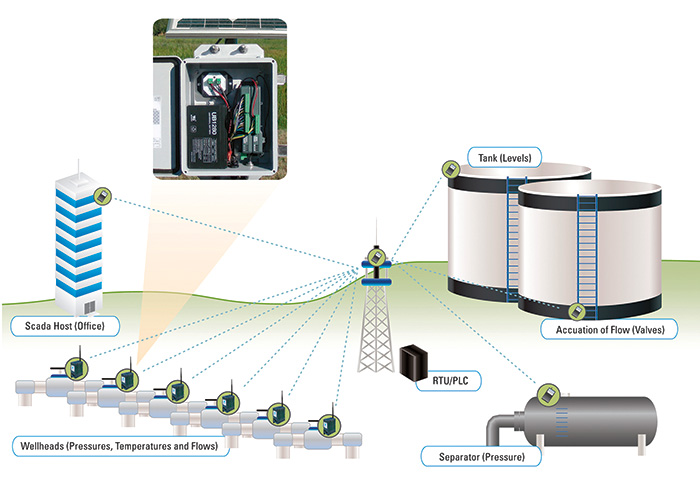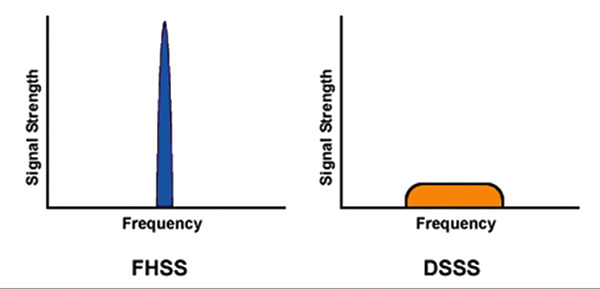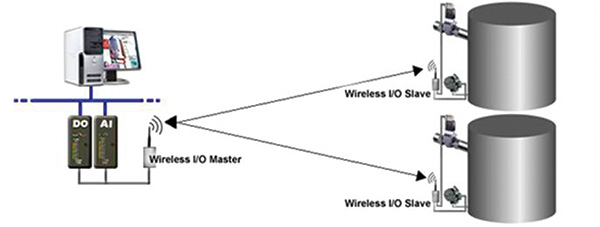Pumps & Systems, April 2013
Fifteen years ago, even the more advanced automation systems seldom supported wireless telemetry. Systems that did employ wired or wireless telemetry offered slow data throughput (9,600 baud or less) and rarely provided coverage to every automated location. This greatly limited the usefulness of the ability to measure data from a distance. Today, it is common to have 100 percent communication to all field locations and to experience data throughput from the field of 19.2 kilobits per second (kbps) or even 38.4 kbps. High-speed backbone telemetry is now available in the megabits range.
Wireless instrumentation is the latest current telemetry trend. It can support analog and digital signals without the constraints of a wired connection. Wireless technology can now be used to communicate to and from pressure or temperature transducers, control valves remotely, flow meter (gallons per minute and total), signal the arrival of switch closures and report status changes or contact closures.
The latest of these telemetry advances is the wireless network. This network is a continuous radio system that communicates from the desktop to the remote terminal unit (RTU) or programmable logic controller (PLC) and then to the field instrument (transducer, valve, etc.) without wired connections on one continuous radio network.
Continuous radio network communication allows end users to check the status of controllers and attached instrumentation and monitor the health of the entire telemetry system. This diagnostic capability is available throughout a supervisory control and data acquisition (SCADA) system on one network.
Several manufacturers now offer radios capable of retrieving data from remote locations. Although several make wireless input/output (I/O), only recently have both capabilities been offered in one communication solution.
These new wireless networks have shifted the conventional attitudes about automation. Previously, some operators believed that telemetry could reliably handle the long haul, sending data from a remote site back to the host. However, the local connections to the instruments needed to be hard-wired to ensure reliability.
The signal strength of an FHSS wireless data radio is much stronger than other options, such as direct-sequence spread spectrum (DSSS).
Types of Networks
Many operators believe a network consists of Cat 5 cable run through the office. In field automation, two more types of networks are available.
The first is the field automation counterpart of the wide area network (WAN), which can extend 10 to 100 miles. This network, often referred to as the “backbone” or “skeleton,” consists of a series of repeaters connecting the host computer to all the remote locations. Depending on the technology, this repeater network can offer high-speed throughput and the ability to bridge many physical obstacles—such as hills, valleys or buildings. The backbone network can cover greater distances than a single radio link. By using multiple repeaters, data can be rebroadcast and will regain full signal strength at every repeater.
With telemetry technologies, such as spread spectrum radio, the same radio used in the RTUs can act as a slave sending data back to the SCADA host. It also acts as a repeater to other field devices or other RTUs. This allows almost limitless expansion of a network by using remote sites as a series of repeaters.
The network uses radios in the RTUs to poll the instruments, creating the second network—a network of instruments that wirelessly reports to the RTU. This short-haul network is equivalent to a local area network (LAN).
New technology features two interlacing networks—the WAN and the LAN—that work on one radio system with a common connection. This common connection is the “slave/master” switchable functionality of the single radio used in the RTU. The radio installed in the RTU is a slave to the SCADA host and a master to the wireless I/O (see Figure 1). 
Figure 1. Some providers offer wireless I/O radios that can act as both a slave and master.

An example of a wireless I/O network
Wireless Economics
Wireless I/O is less expensive than conventional “hard wire” systems and much easier to install.
For example, at a standard oil and gas well site, the operator will transmit measurements from multiple locations back to the RTU or electronic-flow measurement (EFM). When a contractor (such as an electrician) is hired to install these hard-wired connections, the costs are about $16 per foot, whether the application is direct burial cable or conduit and wire. The break-even point for wireless I/O would be about 50 feet, if only the cost of wire and labor are considered. The cost savings multiply when two or more wire runs are required to two different locations. The slave/master radio is already installed in the RTU, meaning the only incremental cost is the additional slave radio.
In process-dependent environments, such as oil and gas refineries, the newest I/O products offer major functional improvements. Wireless I/O removes the enormous challenge of running cable from the point of measurement or control to the process controller. Wireless I/O delivers the most cost-effective method to monitor and optimize a process that spans between 100 feet and 100 miles.
Cost savings begin immediately by eliminating cables and conduits, trenching and construction crews, and permits. Cost savings are noticed with time through quick troubleshooting, over-the-air configuration changes and upgrades, and eliminating cable management. Wireless I/O also can integrate directly into a larger, wireless SCADA network to connect the corporate office with field controllers, process measurements and control points. Process security is enhanced with proprietary frequency hopping spread spectrum (FHSS) wireless technologies.
Time also factors into calculating true installation costs. Using the typical oil and gas well as an example, a crew would work one full day to install wire and trenching for a wellhead to retrieve casing pressure, tubing pressure, plunger arrival and control lines for the valve. The wireless I/O radio can be installed in 20 minutes.
Scheduling conflicts, logistical problems and unexpected costs frequently result from getting the necessary contractors and end users on location at the same time. Compare this with the 20-minute installation of a wireless I/O radio, which allows one man to quickly complete the job and move to his next assignment.
Wireless Reliability
The reliability of wireless products is often questioned. As with all technological innovations, new advancements require patience to learn and implement. Wireless data radio technology has proved itself as a reliable data highway for remote data collection. Reliability remains a stumbling block for advancement of the “new” wireless I/O functionality of radio networks.
Some wireless I/O providers have built safeguards into their networks to help operators address reliability. Examples of this are link alarms, command alarms and autonomous collection mode.
Link alarms alert an operator if the signal between an I/O slave and the RTU has been lost. Operator then know that they are no longer receiving data from their instrument.
Command alarms warn the operator that while the link is operational, a command to change (such as a command to shut a valve) could not be executed. The reason may be mechanical or electrical, but in either case the information is critical. The wireless I/O can supply this alarm.
Autonomous mode means that if an RTU loses its radio link to the SCADA software host, the wireless I/O radio and the radio in the RTU will continue to communicate. The RTU is programmed to be the control on the location. For example, if a tank reaches the high-level mark, the RTU will receive this information from the wireless I/O radio and send (via wireless I/O radio) the command to shut the valve to the tank.
Notification Makes the Difference
No system is completely immune to signal loss. Wired systems are prone to having wires cut during construction or repairs. Lightning, rust, corrosion, steam, dirt, dust and water can affect a wired instrumentation system. The difference is that wire cannot notify the user of a problem, but a radio can. P&S

